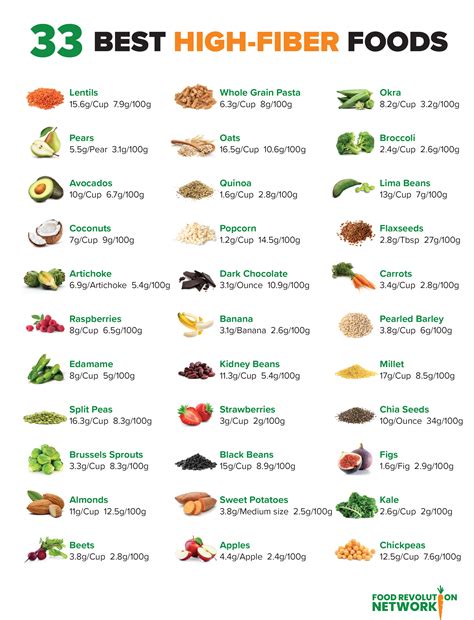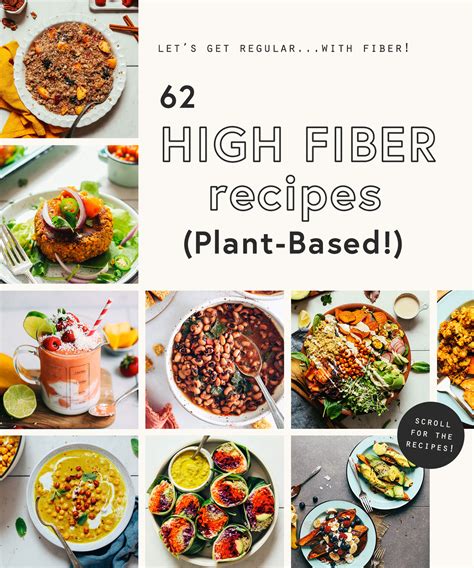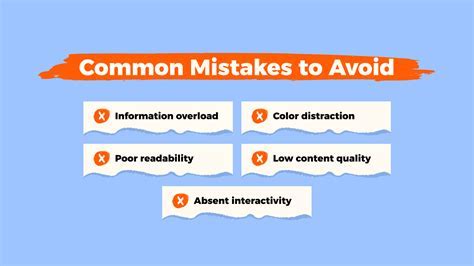Intro
Boost digestive health with top 5 high fiber foods, including fruits, vegetables, and whole grains, rich in dietary fiber, nutrients, and antioxidants for a balanced diet.
Eating a diet rich in fiber is essential for maintaining good health. Fiber helps to promote digestive health, prevent constipation, and support healthy blood sugar levels. It can also help to lower cholesterol levels and reduce the risk of heart disease. Despite its importance, many people do not consume enough fiber in their diets. The daily recommended intake of fiber is 25-30 grams per day, but the average person consumes only about 15 grams per day. Increasing fiber intake can be easy by incorporating high fiber foods into your diet.
Incorporating high fiber foods into your diet can have a significant impact on your overall health. Foods that are high in fiber are often rich in other essential nutrients, such as vitamins, minerals, and antioxidants. They can also help to keep you feeling full and satisfied, making it easier to maintain a healthy weight. Some of the best high fiber foods include fruits, vegetables, whole grains, and legumes. These foods are not only rich in fiber, but they are also low in calories and rich in nutrients.
Eating a diet rich in high fiber foods can also help to support healthy gut bacteria. The gut microbiome plays a crucial role in our overall health, and a diet rich in fiber can help to support the growth of healthy bacteria. This can help to boost the immune system, reduce inflammation, and even improve mental health. With so many benefits, it's no wonder that high fiber foods are an essential part of a healthy diet.
Introduction to High Fiber Foods

Benefits of High Fiber Foods
The benefits of high fiber foods are numerous. They can help to promote digestive health, prevent constipation, and support healthy blood sugar levels. High fiber foods can also help to lower cholesterol levels and reduce the risk of heart disease. Additionally, they can help to keep you feeling full and satisfied, making it easier to maintain a healthy weight. Some of the key benefits of high fiber foods include: * Promoting digestive health * Preventing constipation * Supporting healthy blood sugar levels * Lowering cholesterol levels * Reducing the risk of heart disease * Supporting healthy gut bacteriaTop 5 High Fiber Foods

How to Incorporate High Fiber Foods into Your Diet
Incorporating high fiber foods into your diet can be easy. Here are some tips to get you started: * Start your day with a high fiber breakfast, such as oatmeal with fruit and nuts. * Snack on high fiber foods, such as fruits and vegetables. * Incorporate legumes into your meals, such as adding beans to your favorite soups and stews. * Choose whole grains over refined grains, such as choosing whole wheat bread over white bread. * Add chia seeds or flaxseeds to your meals, such as adding them to your oatmeal or yogurt.High Fiber Food Recipes

High Fiber Food Tips and Tricks
Here are some tips and tricks to help you incorporate more high fiber foods into your diet: * Start slow - If you're not used to eating high fiber foods, start by adding a small amount to your diet and gradually increase your intake. * Drink plenty of water - High fiber foods can be dehydrating, so make sure to drink plenty of water throughout the day. * Be mindful of portion sizes - While high fiber foods are nutritious, they can be high in calories. Be mindful of portion sizes to maintain a healthy weight. * Experiment with new foods - Don't be afraid to try new high fiber foods, such as chia seeds or Brussels sprouts. * Make it fun - Incorporate high fiber foods into your favorite recipes, such as adding beans to your favorite soups and stews.Common High Fiber Food Mistakes

High Fiber Food Myths and Facts
Here are some common myths and facts about high fiber foods: * Myth: High fiber foods are boring and tasteless. * Fact: High fiber foods can be delicious and flavorful, such as roasted Brussels sprouts or avocado toast. * Myth: High fiber foods are only for healthy eaters. * Fact: High fiber foods can be incorporated into any diet, regardless of health goals or preferences. * Myth: High fiber foods are expensive. * Fact: High fiber foods can be affordable, such as buying in bulk or shopping at local farmers' markets.Conclusion and Final Thoughts

We hope this article has provided you with the information and inspiration you need to start incorporating more high fiber foods into your diet. If you have any questions or comments, please don't hesitate to reach out. We'd love to hear from you and help you on your journey to a healthier, happier you.
What are the benefits of high fiber foods?
+High fiber foods provide a range of health benefits, including promoting digestive health, preventing constipation, and supporting healthy blood sugar levels. They can also help to lower cholesterol levels and reduce the risk of heart disease.
How much fiber should I eat per day?
+The daily recommended intake of fiber is 25-30 grams per day. However, the average person consumes only about 15 grams per day. Increasing fiber intake can be easy by incorporating high fiber foods into your diet.
What are some examples of high fiber foods?
+Some examples of high fiber foods include avocados, chia seeds, legumes, whole wheat spaghetti, and Brussels sprouts. These foods are not only rich in fiber, but they are also low in calories and rich in nutrients.
How can I incorporate more high fiber foods into my diet?
+Incorporating more high fiber foods into your diet can be easy. Start by adding a small amount to your diet and gradually increase your intake. Try new foods, such as chia seeds or Brussels sprouts, and experiment with different recipes.
Are high fiber foods expensive?
+High fiber foods can be affordable. Consider buying in bulk or shopping at local farmers' markets. You can also find affordable high fiber foods at your local grocery store.
